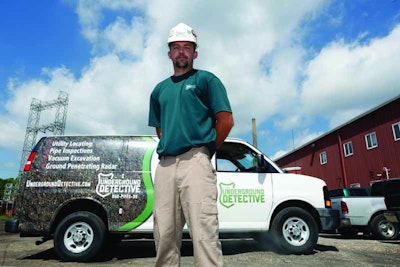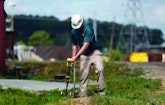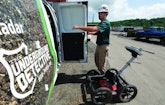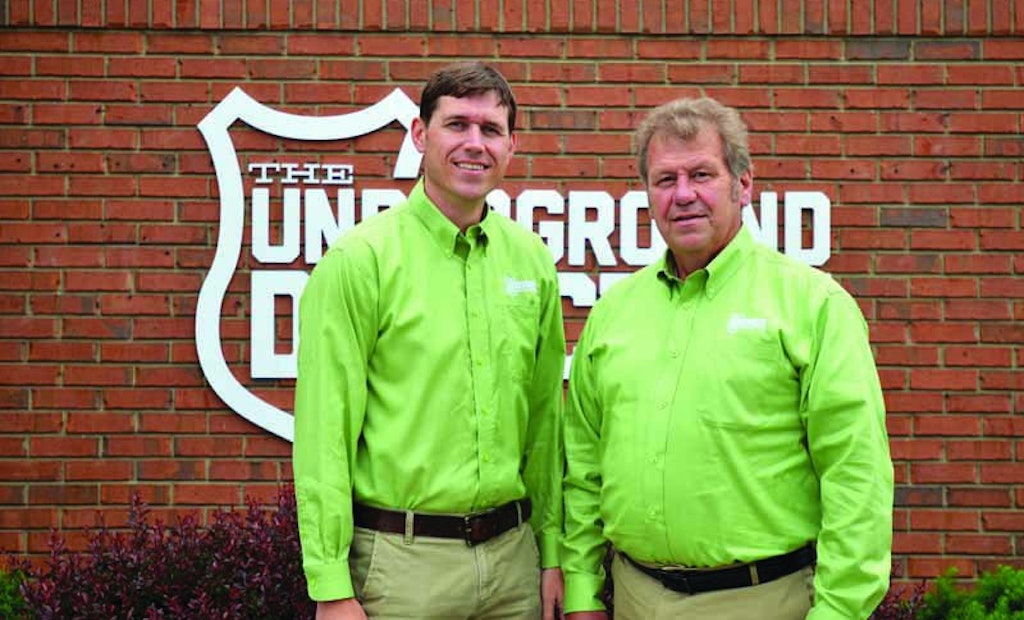Interested in Inspection?
Get Inspection articles, news and videos right in your inbox! Sign up now.
Inspection + Get AlertsIt can take up to a year before a new employee at The Underground Detective is ready to take on a job solo. That's because providing superb service is the top priority for the Cincinnati-based utility locating firm. It's also the reason the business has grown slowly — yet steadily — since its startup more than two decades ago.
“We’re not a fast-moving company,” says Rob Harris, company president. “We’re definitely about gradual growth, but that’s because we like to keep control on the quality of the product. We take a long time to train our employees before we let them run loose on their own. Utility locating is a hard business. You can have all the pieces of equipment in the world and there could still be a utility you might miss. We try to do everything we can to find every utility for customers, and part of that is quality control and making sure our employees are doing all the steps we want them to do.”
New employees begin with several months of training at the home base in Cincinnati, which includes getting caught up on various safety requirements.
“Our safety training is very extensive,” Harris says. “We do a lot of OSHA training and defensive-driver training. There’s not a company out there that we can’t get access to because of our safety training.”
That initial phase of training is followed by several more months of a new hire riding along with some of the company’s more experienced technicians. Then the new employee takes the lead but is still shadowed for a period of time to ensure that they have a complete understanding of the company’s procedures when tackling a locating job.
“It’s a nine-month to yearlong process before they’re out there on their own,” Harris says.
From plumbing to locating
The approach has been profitable for The Underground Detective. The company has grown from a small operation servicing primarily residential customers in only Cincinnati to its current status with four other locations in the country, 20 employees, and mostly commercial clientele.
It’s fitting that this has been the recipe for success because The Underground Detective began as an attempt to provide a higher level of service — just in a different business arena. The company was officially founded in 1992, but began years earlier as a side business for a Cincinnati plumbing company.
“My dad was a plumber by trade and was working for one of his good friends who owned a plumbing company,” Harris says. “They would run into problems when cleaning sewers. If they knew it was broken somewhere, they couldn’t figure out exactly where to dig. So they found a sonde that you could tape onto the end of a sewer auger, and then locate the break above ground.”
Eventually other area plumbers got word and brought in the two men when they needed some underground locating assistance on their own jobs.
“The problem was they would show up in their plumbing van and one plumber working for another didn’t look good, so they eventually got an unmarked van to use for the locating jobs,” Harris says.
Eventually there was enough work to allow the locating to be separated as its own business venture.
“They just kept getting more and more fellow plumbers calling,” Harris says. “The attitude started as, ‘We’ll just run these locating jobs at the end of the day,’ but when they realized they had enough business, that’s what my dad started doing full time.”
Harris joined the company in 1997. At the time, The Underground Detective was still small (three employees) and rarely worked outside of Cincinnati.
“We were primarily residential, but started looking at offering services commercially and just broadening the scope of our work. That’s why I came on, to help continue to grow and expand the services and see where we could take them.”
About 90 percent of The Underground Detective’s business today is with commercial customers. The company has satellite offices in Toledo, Ohio, Knoxville, Tennessee, Philadelphia and Chicago, in addition to the home office in Cincinnati.
Business shift
The shift from residential to commercial customers has been a natural part of the company’s growth.
“Over the years, the price has come down on inspection cameras and plumbers are able to get a hold of those a little easier. Instead of just a handful of plumbers having a camera, now pretty much all of them do. So that work kind of went away, but we’ve picked up other aspects of the job,” Harris says.
The environmental side of locating work is one area in particular that has seen a lot of growth for the company. Locating underground storage tanks prior to a property sale or mapping the site of a gas station where soil testing is required before any belowground work can occur are some of the types of jobs the company is tasked with. That’s where the emphasis on quality training — both in safety and job execution — proves to be particularly important.
“We take our safety training pretty seriously,” Harris says. “Our guys are out in industrial areas and need to be safe while doing their work. There are a lot of annual trainings we continually do, and we also do quarterly audits to check up on them safety wise. And then there are internal audits just to make sure employees are performing their job functions well.”
Ultimately, customers are not able to perform their work safely if The Underground Detective doesn’t do its work properly and locate everything belowground, he says.
“Safety is what we preach to our employees, so we want to make sure our customers are safe as well.”
That means doing a thorough job, utilizing both long-standing locating methods as well as taking advantage of ever-improving technology. Technicians begin by doing a walk-through of a site and observing any clearly visible above-ground signs of where utilities may be located, such as valves and manholes.
“We’ll do your standard utility locate and find everything we can. Then, before we’re done, we do some scanning with ground-penetrating radar (GPR) and electromagnetic equipment just to make sure we’re not missing anything,” Harris says.
The company utilizes GPR equipment from MALA GeoScience and electromagnetic locators from Radiodetection Corporation. The company has also used equipment from Subsite Electronics, Vivax-Metrotech, Prototek, Goldak and RIDGID.
Full spectrum of tools
Technology wise, the biggest development in how The Underground Detective operates has been with GPR, which uses electromagnetic radiation waves and detects the reflected signals from objects below the surface. Harris says the company added GPR to its equipment arsenal in the early 2000s, and as the technology has developed, it has become a valuable asset for more than utility locating (see sidebar). But in the mission to provide exemplary service and locate all belowground structures for customers, the company is careful not to rely too heavily on GPR.
“Technology has gotten better, but as far as the core of the equipment, we’re using stuff we used back then (in the early years of the business),” says Harris.
“With GPR, every one of our trucks is required to have it, and it is always something we can use. But we just consider it another tool in the toolbox. It’s been a wonderful asset, but some people have a misconception that it’s a magic tool and that’s all you need in order to locate everything.”
Technicians use the full spectrum of tools available — including customer education — to deliver quality service. Harris says that over time, more people have realized that with so many private belowground utilities, it’s necessary to call a company like The Underground Detective in addition to using the required 811 service. But a lesson is still sometimes needed.
“You still run across people who don’t get the concept,” Harris says. “811 is the requirement, but there is still definitely a gap there. You really need to call 811 and then a company like ours. It’s just education. We try to blog a lot on our website, we do trade shows, we do ‘Lunch and Learn’ events. I would like to do more of those — any way we can just talk to people.”
In one recent blog, Harris highlighted the benefits of vacuum excavation — another area of the business that has seen a growth trend of late. The Underground Detective uses trucks from Denver-based VACMASTERS to do everything from simply uncovering a utility for inspection to digging entire trenches.
“It’s an everyday thing for us, but the projects vary,” Harris says. “The trenching is becoming more popular with it, instead of a customer using a backhoe. Environmental engineering firms love it for getting the exact details on utilities they’ll be crossing.”
The future
Looking ahead, Harris says the plan is to conduct business in the same manner that has proven successful over the last two decades — continually looking for growth opportunities but doing so gradually so there isn’t a drop in quality of service. The most recent satellite office in Chicago opened last year, but there are no immediate plans for any other new offices at the moment.
“We’re definitely looking to expand in our current markets, just getting bigger and adding more technicians,” Harris says. “The main goal is to have two or three technicians at each location. As far as new growth, we’re still contemplating that.”
From time capsules to cemeteries
While utility locating may be The Underground Detective’s forte, it is not the only area in which the company’s equipment and expertise are useful. Occasionally the Cincinnati-based company is called on to be true detectives, searching for items beneath the surface that don’t even have a helpful starting point, such as an above-ground valve or manhole.
A couple years ago, the company was contacted via Facebook by the National Trail School in New Paris, Ohio. A former student had reminded the school about a forgotten time capsule that had been buried somewhere on the property in 1978. The location of the time capsule was narrowed down some by those who recalled the day it was buried. But that only narrowed it down to the general area of the employee/student parking lot.
The Underground Detective selected a day in which school was not in session so a tech could freely scan the entire area and got to work with ground-penetrating radar (MALA GeoScience). Within two hours, the time capsule was located. A few weeks later, a crew dug up the area the tech had marked. Unfortunately, the excitement of unearthing the capsule was dampened somewhat when it was discovered that the contents had suffered extensive water damage during their 30-plus years underground. Still, the school’s staff and students were excited that the capsule had been located as they hadn’t had any luck until The Underground Detective got involved, says company president Rob Harris. The company was even invited to the banquet for the opening of the capsule, where the tech who did the locating was recognized for his efforts.
“It was a great event to be a part of and an exciting change from the ordinary locating that we often do,” Harris says.
Another opportunity that allows the company to get away from “typical” locating work is cemetery restoration. The Underground Detective sometimes is called on to locate unmarked grave sites.
“Those are fun jobs,” Harris says. “They’re interesting. We don’t do a ton of work with cemetery restoration, but we do more than you would think. We might do about one to three a month.”
On one such job last year, the company was asked to assist in confirming locations for both marked and unmarked gravesites at the Old Green Castle Cemetery in Dayton, Ohio — a cemetery of more than 200 burial sites, mostly Civil War soldiers. Like the time capsule job, GPR technology proved beneficial. The Underground Detective used it to locate nine unmarked gravesites in the cemetery. Harris says GPR is perfect for such a task because it uses nondestructive electromagnetic radiation waves and is able to provide a view below the surface without disturbing it.
“With GPR, we were able to determine exactly where graves were so that they could be properly marked and/or moved to a new site.”












